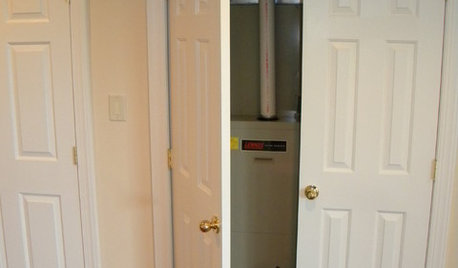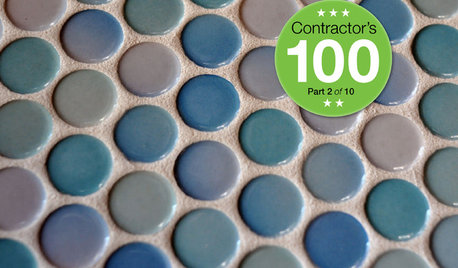First-time home owners and issues with contractor
joelovesjennie
9 years ago
Featured Answer
Sort by:Oldest
Comments (36)
Joseph Corlett, LLC
9 years agolast modified: 9 years agojoelovesjennie thanked Joseph Corlett, LLCRelated Discussions
First time home owner with watering question
Comments (1)follow this irrigation schedule after planting your new seeds. water 15-20 minutes twice a day for two weeks water 20-30 minutes once a day for one week water 30-45 minutes once a day every other day for one week water 30-45 minutes once a day twice a week for one week move into deep irrigation, increasing the time to provide 1 inch of water all over and decreasing the frequency to just once a week. If you have to move the sprinklers at any point, the new location also receives 1 inch. After seeding, baby the grass by staying off for 1-2 months. Mow when the new seeds reach 4 inches and mow it back to 3....See MoreFirst time home owner, replacing HVAC please advise
Comments (8)I agree with Mr Salesman that a heat pump is the way to go. I'm not even sure why you have gas heat in Florida. Electric back-up strips can be used in the air handler, or you can have a gas furnace in the air handler as supplimental heat. Below 32 degrees F outside air, a house loses heat faster than the heat pump can supply it, so supplimental heat is needed. What are your electric costs ($ per kw-hr). The 2TTX5042 condenser with 2TEE3F40 is a matched set rated at 42,500 btu-hr, 12.8 EER, and 15 SEER. These are fantastic numbers. Your true cost of operation is determined by EER and not SEER, much to the surprise of many people. EER is rated at 95 degrees outside air temps while SEER is rated at only 82 degrees outside air temps. That air handler does have a variable speed blower. The 2TTX5042 condenser with a 2TXCC049 air handler and UD080R9V furnace is also a matched set rated at 40,500 btu-hour, 15.25 SEER, and 12.8 EER. Not sure if the blower is variable speed. You may be able to check Trane's website for that info - search on the furnace model#. There are no HSPF ratings since the above systems are not heat pumps. For your piece of mind, you should consider a PARTS AND LABOR warranty. The manufacturer's warranty is parts-only, no labor. You can search www.energystar.gov to find the rebate requirements. You'll have to step up to the XL16i with the right air handler to get the required SEER/EER/HSPF. All 3 must be met to get the rebate. The 16i uses a 2-stage compressor. Typically these systems are much more $$ to purchase than single stage compressors. The VisionPro is loved by the pros. The VisionPro IAQ is even more advanced. You can check them out on Honeywell's website. You ask solid questions. An HVAC-educated homeowner (myself included) helps to insure a good purchase, a good install, and a happy ending. Best to you. Here is a link that might be useful: ARI Directory...See MoreWater Softener - first time home owner
Comments (6)Soft water pros... longer service life for plumbing, appliances, and fixtures. Your tankless will thank you. Clothes last longer and are softer to wear. You'll use less soap and detergent and shampoo. It will be a long time before you fix a leaky faucet. Based on your numbers and occupancy (including future baby for 4th person) here's my recommendation if you're on a water system. If you're on a well then things change. 1.5 cu ft (standard hi-capacity 10% cross-linked resin... NOT FINE MESH) softener using a Fleck 7000SXT or Clack WS1 control valve on your 1.25" softener loop with appropriate connectors so you don't reduce the plumbing size. Choice of brine tank with salt grid and Fleck 2310 safety float brine pickup. A bypass will come with either control valve and you'll want a top basket for the control valve AND a gravel under bed. This is the setup you want... don't let anyone talk you out of it. Set up for efficiency it will regenerate every 8 days or so and use about one bag of salt a month. Use those specs and shop around for a local water treatment professional. They won't program the softener correctly but I can give you the #s and you make them set it up that way. With 15 gpg hardness and 320 TDS you should consider an under sink RO in the kitchen for drinking, cooking, and ice making water....See MoreFirst Time Home Owner - Inspector Results (pics)
Comments (11)Based on my own experience, I would say that unless there is something uniquely compelling to you about this house, I would walk away. I think it is a fair bet that the money you spend on the repairs will not translate into commensurate equity. In other words, if you spend X on the house and Y on the repairs, when you are done, you will NOT have a house that you could sell for (X + Y). You'd be better served buying a house worth (X + Y) that needs no repairs. Also, keep in mind that any estimates you get from inspectors, structural engineers, or whomever, are just that -- estimates -- NOT contracts to actually do the work. When we bought our home, we had a long list of defects and remediation estimates from our inspection. The actual cost of fixing these defects turned out to be at least 3-4 times the inspector's estimates. And that doesn't even count all the things that the inspector did not find. We love our old house, but financially it has been a disaster. In hindsight, I wish we had walked away when we got the inspector's report (which was not even as bad as yours.)...See MoreVertise
9 years agoJoseph Corlett, LLC
9 years agojoelovesjennie
9 years agoJoseph Corlett, LLC
9 years agolast modified: 9 years agojoelovesjennie thanked Joseph Corlett, LLCjellytoast
9 years agojoelovesjennie
9 years agoUser
9 years agoJoseph Corlett, LLC
9 years agolast modified: 9 years agojoelovesjennie
9 years agojoelovesjennie
9 years agoVertise
9 years agojoelovesjennie
9 years agoChristopher Nelson Wallcovering and Painting
9 years agojoelovesjennie thanked Christopher Nelson Wallcovering and Paintingjoelovesjennie
9 years agojoelovesjennie
9 years agojoelovesjennie
9 years agojoelovesjennie
9 years ago
Related Stories

ARCHITECTUREGet a Perfectly Built Home the First Time Around
Yes, you can have a new build you’ll love right off the bat. Consider learning about yourself a bonus
Full Story
REMODELING GUIDESContractor's Tips: 10 Things Your Contractor Might Not Tell You
Climbing through your closets and fielding design issues galore, your contractor might stay mum. Here's what you're missing
Full Story
MOST POPULARA First-Time Buyer’s Guide to Home Maintenance
Take care of these tasks to avoid major home hassles, inefficiencies or unsightliness down the road
Full Story
REMODELING GUIDESContractor Tips: What Your Contractor Really Means
Translate your contractor's lingo to get the communication on your home project right
Full Story
CONTRACTOR TIPSContractor Tips: How to Shop for Your Remodel
Small mistakes in buying remodeling materials can add up to huge cost overruns. Here's how to get things right the first time
Full Story
WORKING WITH PROS7 Tips for Making Contractors Your Allies
For a contractor as vested as you are in your home project's success, follow these time-tested techniques from a professional designer
Full Story
REMODELING GUIDESContractor Tips: 10 Hats Your General Contractor Wears
Therapist, financial advisor, mediator — for the price of a single good contractor on your remodel, you're actually getting 10 jobs done
Full Story
BATHROOM DESIGNDreaming of a Spa Tub at Home? Read This Pro Advice First
Before you float away on visions of jets and bubbles and the steamiest water around, consider these very real spa tub issues
Full Story
MOST POPULARFirst Things First: How to Prioritize Home Projects
What to do when you’re contemplating home improvements after a move and you don't know where to begin
Full Story
You Said It: Hot-Button Issues Fired Up the Comments This Week
Dust, window coverings, contemporary designs and more are inspiring lively conversations on Houzz
Full StorySponsored
Columbus Area's Luxury Design Build Firm | 17x Best of Houzz Winner!





weedyacres